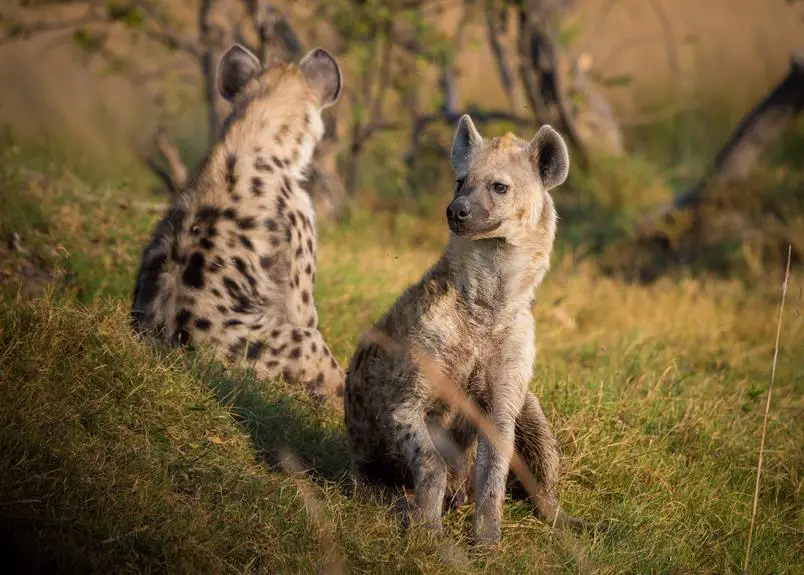Hyenas (Hyaenidae) are found primarily in various habitats of Africa, as well as Arabia and India. They are one of the smaller Carnivora mammals, ranging from about 3 to 5 feet in length, and weighing 100 to 150 pounds.
There are 4 species of hyenas: spotted, striped, brown, and aardwolf. The spotted hyena has rounded ears, and the others have pointed ones.
The article explores a fascinating collection of animals similar to hyenas in appearance, behavior, and habitat. Through vivid images, readers are introduced to canids like the African Painted Dog, Dingo, Coyote, and Wolf, as well as nocturnal creatures like the African Civet, Fox, Genet, and Tasmanian Devil.
Delving into their hunting behavior, social dynamics, vocalizations, and scavenging habits, this article sheds light on the intriguing similarities between hyenas and other carnivores. Discover how these unique adaptations have allowed them to thrive in diverse ecosystems worldwide.
Key Takeaways
- African Painted Dog, Dingo, Coyote, and Wolf have similar features, hunting behavior, and social group behavior to Hyenas.
- Dingo, Coyote, Wolf, and Jackal have similar ear shape and long tails to Hyenas.
- African Civet, Fox, Genet, and Tasmanian Devil exhibit similar nocturnal behavior to Hyenas.
- Tasmanian Devil, Striped Hyena, and Brown Hyena have similar scavenging behavior to Hyenas.
African Painted Dog
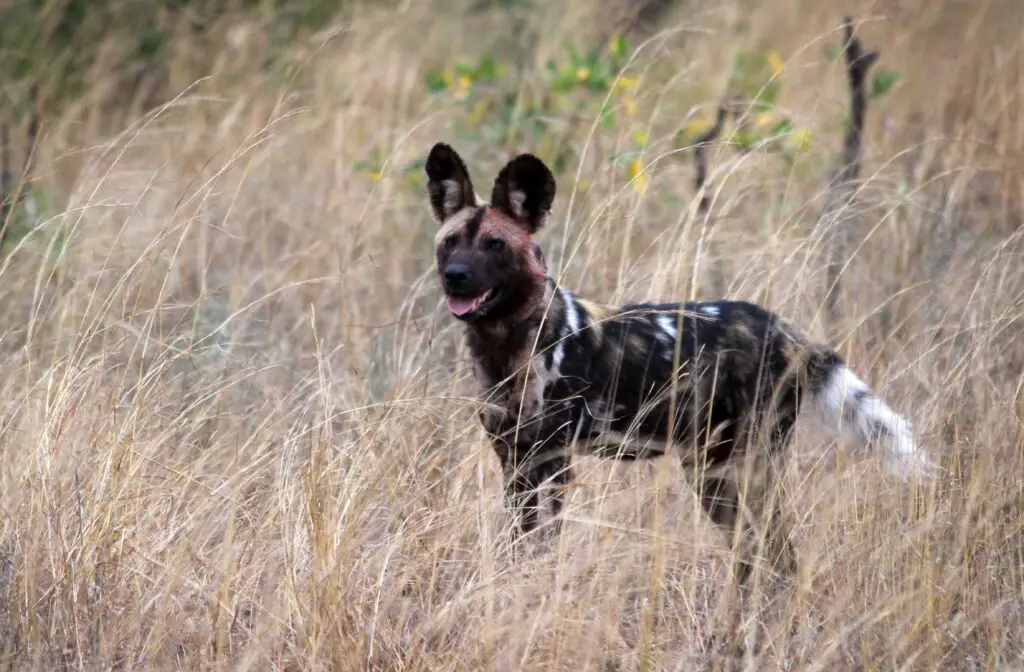
The African Painted Dog, also known as Lycaon pictus, is a canid species that shares similar features and hunting behavior with hyenas. When comparing their hunting strategies, both African painted dogs and hyenas are skilled hunters, known for their cooperative hunting techniques. However, there are also notable differences in their hunting behaviors.
African painted dogs rely on their exceptional speed and endurance to chase down their prey, while hyenas are known for their scavenging abilities and ability to take down larger prey.
In terms of social behaviors, African painted dogs and hyenas also exhibit both similarities and differences. Both species live in highly structured social groups, with African painted dogs forming tight-knit packs and hyenas living in complex matriarchal clans.
Both species also exhibit cooperative care for their young. However, hyenas are known for their dominance hierarchies and intense competition within their clan, while African painted dogs have a more egalitarian social structure.
Dingo

A dingo is a wild dog species that shares similar features and hunting behavior to hyenas. Although it may not be as well-known as its African counterpart, the African Painted Dog, the dingo is a fascinating creature in its own right. Let’s compare the dingo and the African Painted Dog in terms of appearance and behavior.
| Dingo | African Painted Dog |
|---|---|
| Appearance | Similar to a domestic dog with a lean body, erect ears, and a bushy tail. Colors range from sandy yellow to reddish-brown. |
| Behavior | Highly adaptable and known for their intelligence. They form small family groups and are skilled hunters. |
Now, let’s explore the similarities and differences in hunting strategies between the dingo and another canid, the coyote. While both species are opportunistic hunters, the dingo primarily hunts alone or in small groups, relying on stealth and stamina to catch prey. On the other hand, the coyote is known for its cooperative hunting behavior, often hunting in larger packs to take down larger prey. These differences in hunting strategies highlight the unique adaptations and behavior of these canid species.
Coyote
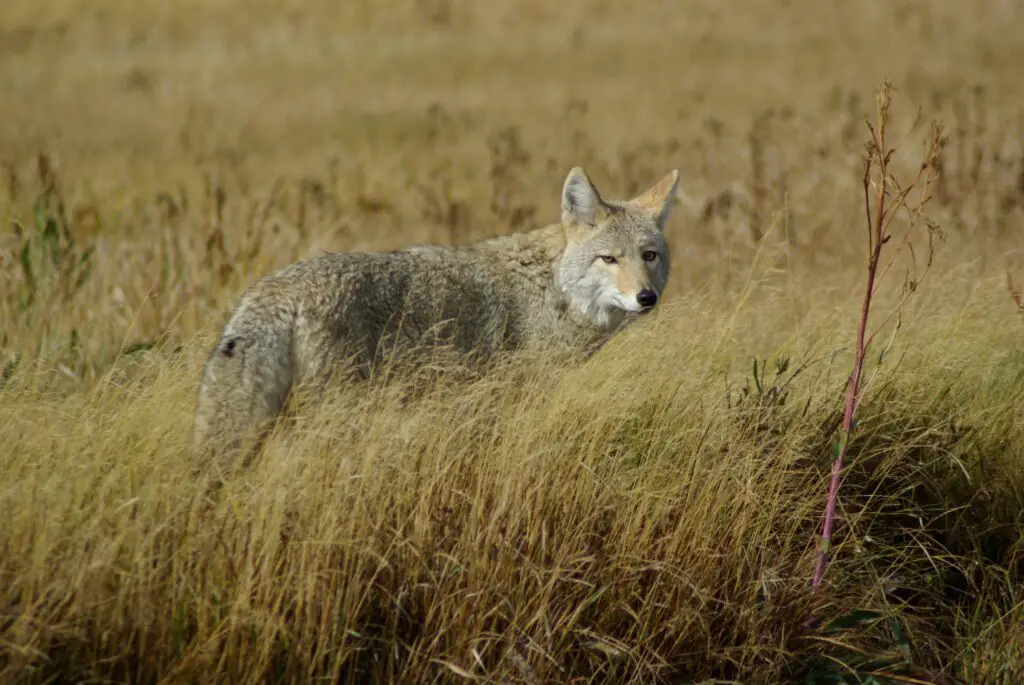
Continuing the comparison of canids with similar hunting behavior to hyenas, the coyote is another fascinating species worth exploring.
Coyotes (Canis latrans) are medium-sized canids native to North America. They’ve a slender, dog-like appearance with a bushy tail and pointed ears.
While hyenas are known for their scavenging behavior, coyotes are primarily opportunistic predators, hunting a variety of small to medium-sized mammals, birds, and reptiles. They employ different hunting strategies compared to hyenas, relying on their keen senses of hearing and smell to locate prey.
Coyotes are known for their ability to adapt to different environments, including urban areas, and their predation can have a significant impact on local ecosystems. By controlling populations of small mammals, they can help regulate these populations and maintain a balanced ecosystem.
However, their predation on livestock can also lead to conflicts with humans. Overall, the coyote’s hunting strategies and role in local ecosystems make it a remarkable species to study.
Wolf
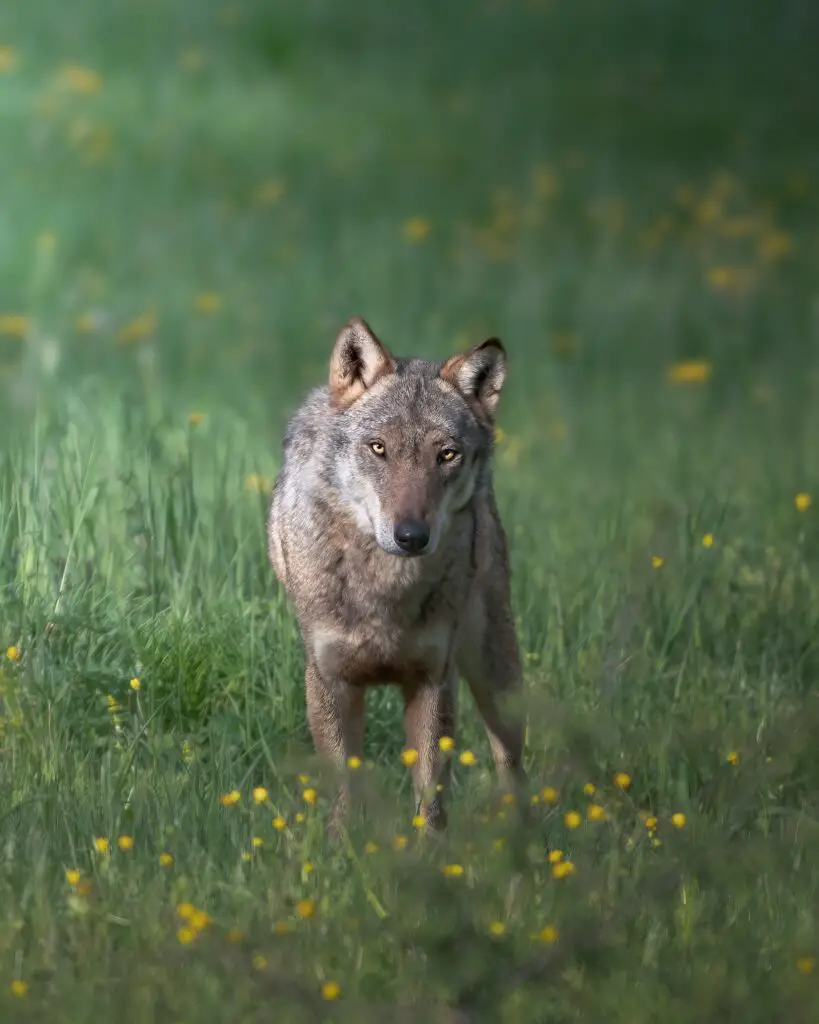
Another canid that shares similar features and hunting behavior to hyenas is the wolf. Wolves belong to the Canis lupus species and are known for their social dynamics and cooperative hunting strategies.
Comparing the hunting behavior of wolves and hyenas reveals some interesting similarities. Both species are highly skilled predators that rely on teamwork to take down large prey. Wolves often hunt in packs, utilizing their strength in numbers to bring down animals much larger than themselves. Similarly, hyenas also form social groups called clans, where individuals work together to secure their meals.
The social dynamics between wolves and hyenas are different, as wolves have a strict hierarchical structure within their packs, while hyenas exhibit a matriarchal society. Despite these differences, both wolves and hyenas demonstrate remarkable hunting abilities and cooperative behaviors.
Jackal

The jackal, another canid with similar ear shape and long tail to hyenas, is known for its adaptability and opportunistic hunting behavior. Here are three key points to consider when comparing jackals to hyenas:
1) Behavior and Diet: Both jackals and hyenas are highly adaptable and opportunistic hunters. They’re skilled scavengers, often targeting the leftovers of larger predators. However, while hyenas are primarily scavengers, jackals also actively hunt small prey like rodents and birds.
2) Physical Characteristics: In terms of physical characteristics, jackals and hyenas share some similarities. Both have a similar ear shape and long tail, although hyenas are larger and bulkier in size compared to jackals. Additionally, jackals have a sleeker body structure and a more pointed muzzle compared to hyenas.
3) Social Behavior: Hyenas are highly social animals, living in large groups called clans. Jackals, on the other hand, tend to live in smaller family groups or pairs. This difference in social structure is reflected in their hunting and territorial behaviors.
African Civet
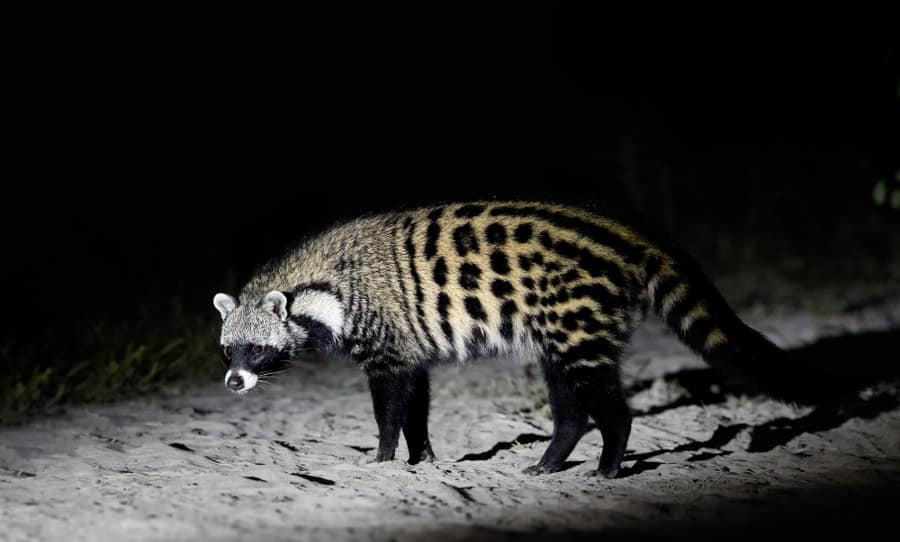
Having discussed the jackal’s similarities to hyenas in terms of ear shape and long tail, it is important to now shift our focus to the African Civet. The African Civet (Civettictis civetta) is a nocturnal carnivore that shares behavioral similarities with hyenas. This species plays a crucial role in the ecosystem, contributing to the balance of predator-prey dynamics and seed dispersal.
| Behavioral Similarities with Hyenas | Role in the Ecosystem |
|---|---|
| Nocturnal behavior | Seed dispersal |
| Scavenging behavior | Predator control |
| Solitary or small group living | Nutrient recycling |
| Excellent night vision | Maintaining biodiversity |
African Civets, like hyenas, are primarily nocturnal and possess excellent night vision. They engage in scavenging behavior, helping to control the population of carrion and maintain a healthy ecosystem. Additionally, African Civets play a significant role in seed dispersal, aiding in the regeneration of plant species. Their solitary or small group living supports nutrient recycling and contributes to the overall biodiversity of their habitat. Overall, the African Civet is a vital species in the intricate web of interactions within its ecosystem.
Genet

A few genets, small carnivores with similar nocturnal behavior to hyenas, share certain characteristics. These nocturnal creatures possess unique features and hunting techniques that distinguish them from other carnivores. Here are three key aspects that set genets apart:
- Unique characteristics: Genets have a slender body with a long tail, which aids in balance while climbing trees. They’ve a pointed muzzle, large ears, and sharp retractable claws. Their fur is typically spotted or striped, providing excellent camouflage in their forested habitats.
- Hunting techniques: Genets are agile hunters, known for their ability to climb trees and pounce on unsuspecting prey from above. They’ve sharp teeth and strong jaws, enabling them to catch and kill small mammals, birds, reptiles, and insects. Their nocturnal nature gives them an advantage in hunting during the cover of darkness.
- Comparison with other nocturnal carnivores: While genets share some similarities with other nocturnal carnivores like the African Civet and the Tasmanian Devil, they’ve distinct physical features and hunting strategies that set them apart. Unlike hyenas, genets are solitary animals and don’t exhibit the same social group behavior.
Tasmanian Devil
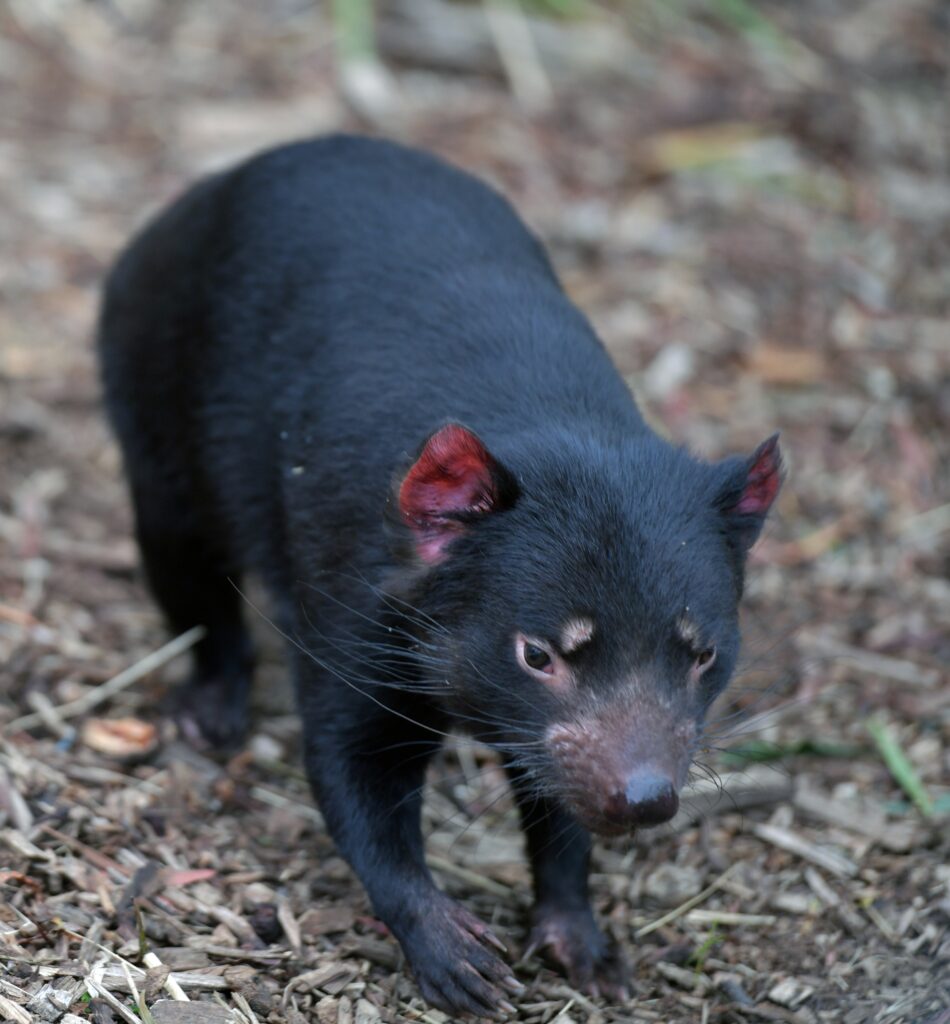
Continuing the exploration of nocturnal carnivores, the Tasmanian Devil possesses unique characteristics that distinguish it from other animals like hyenas. The Tasmanian Devil, scientifically known as Sarcophilus harrisii, is a carnivorous marsupial native to the island state of Tasmania, Australia. It is characterized by its stocky build, black fur, and powerful jaws. The Tasmanian Devil primarily inhabits dense forests and scrublands, but can also be found in coastal heathlands and agricultural areas. In terms of hunting strategies, the Tasmanian Devil differs from hyenas. While hyenas are primarily scavengers, the Tasmanian Devil is an opportunistic hunter, preying on small mammals, birds, reptiles, and insects. It relies on its strong sense of smell and hearing to locate prey and uses its sharp teeth and powerful bite to capture and consume its meals.
| Behavior and Habitat of Tasmanian Devil | Comparison of Tasmanian Devil and Hyenas in terms of hunting strategies |
|---|---|
| Carnivorous marsupial | Hyenas are primarily scavengers |
| Native to Tasmania, Australia | Tasmanian Devil is an opportunistic hunter |
| Inhabits forests, scrublands, and more | Relies on sense of smell and hearing to locate prey |
Mongoose

Mongoose and hyena are both carnivorous mammals, but they belong to different families and exhibit several differences and similarities:
Differences:
Taxonomy:
- Mongoose: Mongeese belong to the family Herpestidae, and they are more closely related to civets and meerkats.
- Hyena: Hyenas belong to the family Hyaenidae, and they are more closely related to cats.
Size:
- Mongoose: Typically smaller in size, with some species being as small as 7 inches in length (dwarf mongoose) and others reaching about 2.5 feet (white-tailed mongoose).
- Hyena: Generally larger animals, with an average length ranging from about 3 to 6.6 feet, depending on the species.
Habitat:
- Mongoose: Often inhabit a wide range of environments, including grasslands, forests, and deserts.
- Hyena: Primarily found in savannas and open woodlands.
Social Structure:
- Mongoose: Many mongoose species are known for their social behavior and live in groups, called mobs or packs. They work together to forage and defend their territory.
- Hyena: Hyenas are also highly social animals, living in groups called clans. They have a complex social hierarchy and cooperative hunting strategies.
Diet:
- Mongoose: Primarily insectivorous, with a diet that includes insects, small vertebrates, and fruits.
- Hyena: Carnivorous scavengers, with a diet that includes carrion, small to medium-sized mammals, and sometimes plant matter.
Similarities:
- Carnivorous: Both mongoose and hyena are carnivorous mammals, meaning they primarily eat animal flesh.
- Nocturnal: Both mongoose and hyena are often active during the night, although they may also be active during the day, depending on the species.
- Strong Jaws: Both animals have powerful jaws and teeth adapted for tearing and consuming meat.
- Territorial Behavior: Both mongoose and hyena species exhibit territorial behaviors and defend their territory from other individuals or groups.
- Agile and Swift: Both mongoose and hyena species are known for their agility and speed, which helps them in hunting or scavenging.
- Complex Social Structures: Both mongoose and hyena species have complex social structures and engage in cooperative behavior within their groups.
In summary, while mongoose and hyena share some similarities, such as being carnivorous, having strong jaws, and exhibiting complex social structures, they differ in terms of size, taxonomy, habitat, and diet. Each species has evolved to fill a distinct ecological niche and exhibit unique behaviors to survive in their respective environments.
Fox
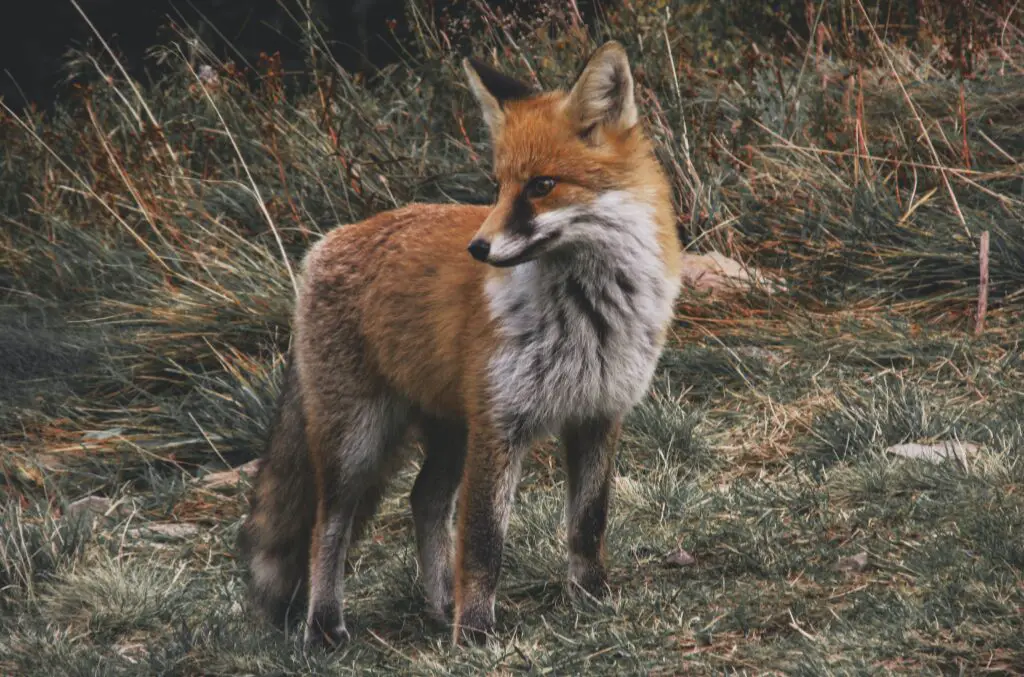
Hyenas and foxes are two different types of carnivorous mammals, and they exhibit various differences and similarities:
Differences:
Taxonomy:
- Hyenas belong to the family Hyaenidae, which is more closely related to cats and mongooses.
- Foxes belong to the family Canidae, making them closer relatives to dogs, wolves, and other canines.
Size:
- Hyenas are generally larger animals, with an average length ranging from about 3 to 6.6 feet, depending on the species.
- Foxes are typically smaller in size, with an average length ranging from about 1 to 3 feet.
Habitat:
- Hyenas are primarily found in savannas and open woodlands, favoring warm and arid environments.
- Foxes inhabit a broader range of environments, including forests, grasslands, deserts, and urban areas.
Social Structure:
- Hyenas are highly social animals, living in groups called clans. They have a complex social hierarchy and cooperative hunting strategies.
- Foxes are generally solitary animals or live in small family groups. They have less complex social structures compared to hyenas.
Diet:
- Hyenas are primarily carnivorous scavengers, with a diet that includes carrion, small to medium-sized mammals, and sometimes plant matter.
- Foxes are omnivores, meaning they eat both animal and plant matter. Their diet may include small mammals, birds, insects, fruits, and vegetation.
Similarities:
- Carnivorous: Both hyenas and foxes are carnivorous mammals, meaning they primarily eat animal flesh.
- Nocturnal: Both hyenas and foxes are often active during the night, although they may also be active during the day, depending on the species.
- Strong Jaws: Both animals have powerful jaws and teeth adapted for tearing and consuming meat.
- Territorial Behavior: Both hyenas and foxes exhibit territorial behaviors and defend their territory from other individuals or groups.
- Adaptability: Both hyenas and foxes are highly adaptable animals capable of thriving in various environments.
- Vocalization: Both animals are known for their vocalizations. Hyenas are famous for their whooping calls, while foxes produce a variety of sounds, including barks and howls, to communicate with one another.
In summary, hyenas and foxes share some similarities, such as being carnivorous and having strong jaws, but they differ in terms of size, taxonomy, habitat, social structure, and diet. These differences are a result of their distinct evolutionary paths and adaptations to their respective environments.
Aardwolf
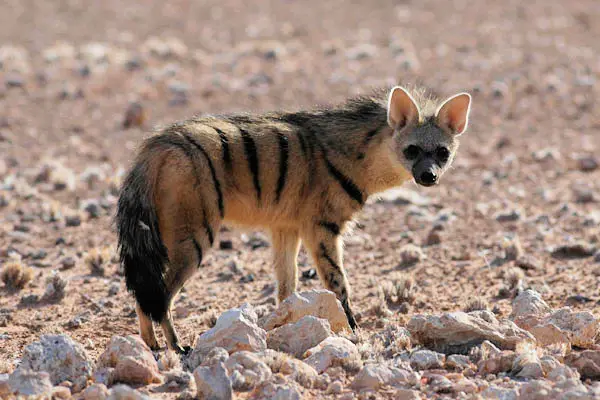
The aardwolf (Proteles cristata) is a unique member of the hyena family (Hyaenidae) and differs significantly from other hyena species in several key ways:
Diet:
- Aardwolf: Aardwolves are insectivores, primarily feeding on termites and other small insects. They use their long, sticky tongue to lap up insects from the ground and inside termite mounds.
- Other Hyena Species: Other hyena species are primarily carnivorous scavengers, with diets that include carrion, small to medium-sized mammals, and sometimes plant matter. They rarely feed on insects.
Physical Appearance:
- Aardwolf: Aardwolves are the smallest members of the hyena family. They have a slender, dog-like appearance, distinct from the stockier and more robust build of other hyena species.
- Other Hyena Species: Other hyenas have a more robust build with a sloping back and coarse, bristly fur. They are larger and more muscular compared to aardwolves.
Social Structure:
- Aardwolf: Aardwolves are usually solitary or form small family groups. They are not as social as other hyena species and do not live in large clans.
- Other Hyena Species: Other hyenas are highly social and live in groups called clans, with complex social hierarchies. They work together in cooperative hunting and scavenging.
Territorial Behavior:
- Aardwolf: Aardwolves establish and defend territories to find abundant termite food sources.
- Other Hyena Species: Other hyena species also establish territories but do so to defend large areas with access to a variety of food sources, including carrion and live prey.
Vocalization:
- Aardwolf: Aardwolves are relatively quiet and do not produce the loud vocalizations commonly associated with other hyenas.
- Other Hyena Species: Other hyena species are known for their vocalizations, including the famous whooping calls, which they use to communicate with clan members and establish their presence.
Dietary Adaptations:
- Aardwolf: Aardwolves have specialized adaptations for their insectivorous diet, including a long tongue and reduced dentition, with fewer teeth compared to other hyenas.
- Other Hyena Species: Other hyenas have powerful jaws and teeth adapted for tearing and consuming meat.
In summary, the aardwolf differs significantly from other hyena species in terms of diet, physical appearance, social structure, territorial behavior, vocalization, and dietary adaptations. These differences reflect the aardwolf’s unique adaptation to its specific ecological niche as a specialized insectivore, setting it apart from the more typical carnivorous scavengers of the hyena family.
Striped Hyena
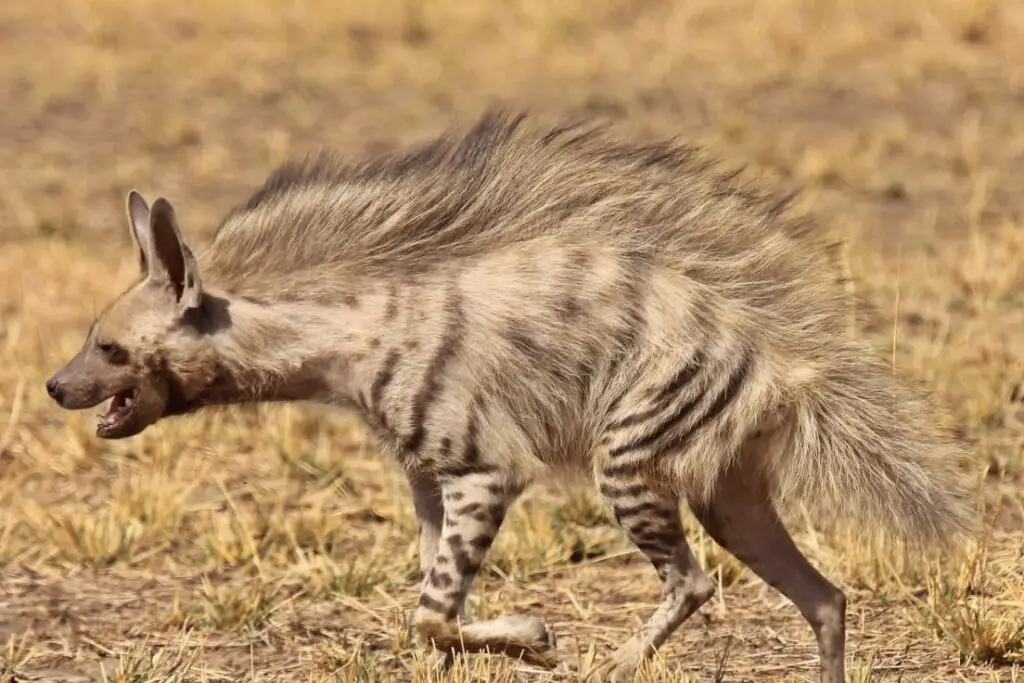
Here are three interesting facts about the Striped Hyena:
- Hunting Behavior: The hunting behavior of striped hyenas is quite different from that of African painted dogs. While African painted dogs are skilled cooperative hunters, striped hyenas are primarily scavengers. They rely on their powerful jaws and sharp teeth to consume carrion and leftovers from other predators’ kills.
- Social Group Behavior: Striped hyenas exhibit social behaviors similar to coyotes. They live in small family groups, with a dominant pair leading the pack. These groups work together to defend territories, hunt, and raise their young. The social structure within striped hyena packs is complex, with individuals communicating through vocalizations and scent marking.
- Unique Adaptations: Striped hyenas have several unique adaptations that distinguish them from other hyenas and canids. They have a distinctive striped coat, large rounded ears, and a long mane along their back. These features provide camouflage in their arid habitats and help regulate body temperature. Additionally, striped hyenas have a powerful digestive system that allows them to consume bone and other tough materials.
Brown Hyena
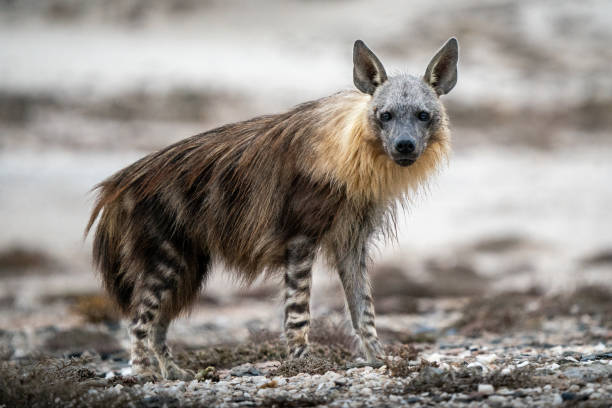
Brown Hyenas are known for their unique appearance and scavenging behavior. These hyenas have adapted several unique features that allow them to thrive in their environment.
Unlike other hyena species, brown hyenas have longer legs and a more slender body shape, which enables them to cover large distances in search of carrion. They also have a specialized dentition, with large premolars and molars that are well-suited for crushing bones. This allows them to access the nutrient-rich marrow inside carcasses that other scavengers may not be able to reach.
In addition, brown hyenas have powerful jaws and strong neck muscles, which allows them to break open bones and access the rich food source within. These adaptations give brown hyenas a competitive advantage in scavenging, distinguishing them from other hyena species.
Spotted Hyena
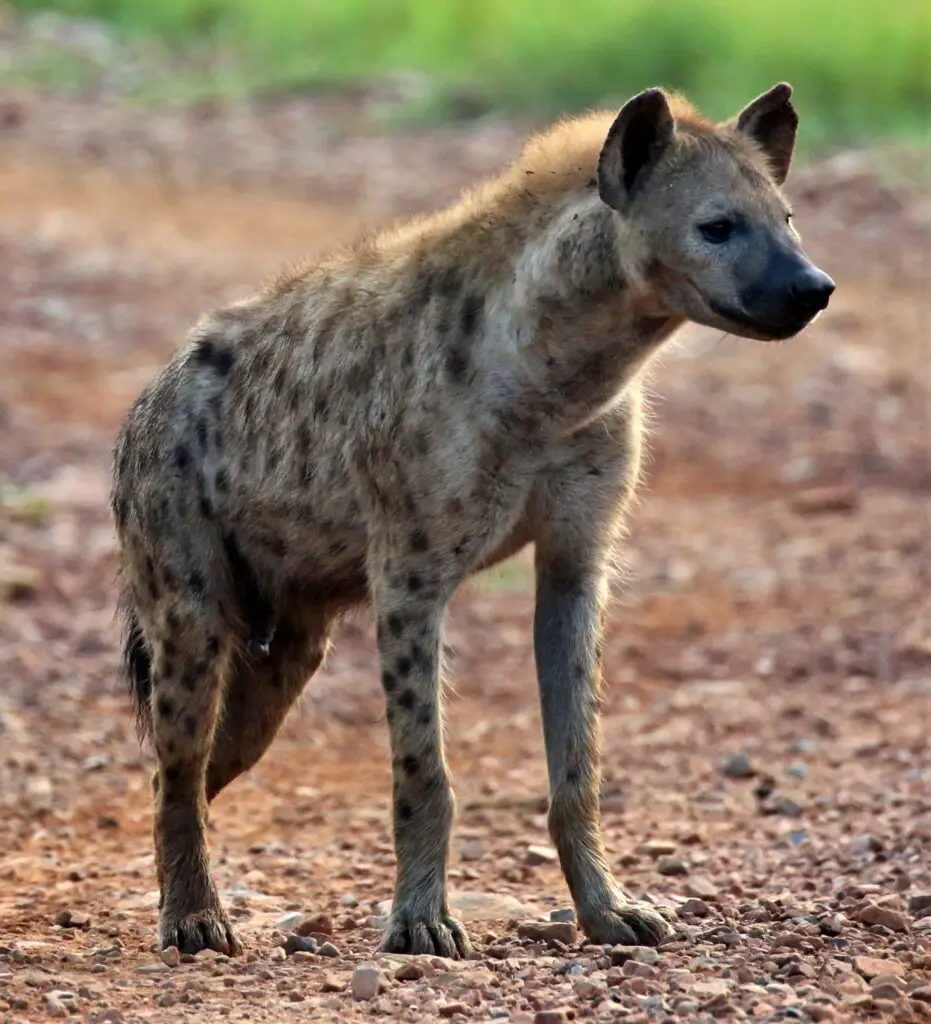
Spotted hyenas (Crocuta crocuta) are a distinct species within the hyena family (Hyaenidae) and differ from other hyena species in several notable ways:
Physical Appearance:
- Spotted Hyena: Spotted hyenas are the largest and most robust of all hyena species. They have a unique appearance with a sloping back, powerful jaws, and a bristly coat covered in distinct spots.
- Other Hyena Species: Other hyena species are generally smaller and have different body shapes. They do not have the striking spotted pattern, and their coats are typically less bristly.
Habitat and Range:
- Spotted Hyena: Spotted hyenas are found in a wider range of habitats, including grasslands, savannas, and woodlands, and have a broader geographical distribution, being found throughout sub-Saharan Africa.
- Other Hyena Species: Other hyena species have more specific habitat preferences and are often associated with particular regions or types of environments. For example, striped hyenas are found in arid and semi-arid regions.
Social Structure:
- Spotted Hyena: Spotted hyenas are known for their complex and hierarchical social structure. They live in large groups called clans, with a matriarchal system where females are dominant over males.
- Other Hyena Species: Other hyena species have different social structures. For instance, striped hyenas are generally solitary or live in small family groups, and brown hyenas live in smaller and less hierarchical groups.
Vocalization:
- Spotted Hyena: Spotted hyenas are famous for their vocalizations, which include a wide range of calls such as whoops, laughs, and growls. Their vocalizations play a crucial role in communication within the clan.
- Other Hyena Species: While other hyenas also vocalize, their vocal repertoires are less diverse and less well-known compared to spotted hyenas.
Diet and Hunting Behavior:
- Spotted Hyena: Spotted hyenas are skilled hunters and scavengers, with a diet that includes a variety of prey, from small mammals to larger ungulates. They are known for their powerful jaws and ability to crush and digest bones.
- Other Hyena Species: Other hyena species have different dietary preferences. For instance, striped hyenas are more scavengers and feed on carrion, while brown hyenas are omnivorous, incorporating a wider range of food items into their diet.
In summary, spotted hyenas are distinctive within the hyena family due to their larger size, unique spotted appearance, broad habitat range, complex social structure, vocalizations, and specialized hunting behavior. These characteristics reflect their adaptability and evolutionary path, setting them apart from other hyena species.
Other Carnivores
Other carnivores, such as the striped hyena and the Tasmanian devil, share similar nocturnal behavior and scavenging habits with hyenas. These carnivores exhibit a diet that’s comparable to hyenas, feasting on a wide range of prey including carrion, small mammals, birds, and even insects. They’re opportunistic feeders, relying on their keen sense of smell to locate food sources.
Like hyenas, these carnivores are skilled scavengers, often taking advantage of the leftovers from other predators’ kills. Their scavenging behavior allows them to thrive in a variety of habitats and adapt to changing food availability.
With their similar dietary preferences and scavenging behavior, these carnivores play an important role in maintaining the ecological balance of their respective ecosystems.
Frequently Asked Questions
How Do Hyenas Communicate With Each Other?
Hyenas communicate with each other using a combination of vocalizations and body language. They use various calls, such as whoops, laughs, and growls, to convey information about their location, social status, and intentions. Body postures and facial expressions also play a crucial role in their communication.
What Is the Diet of African Painted Dogs?
African painted dogs, also known as African wild dogs, primarily have a diet consisting of meat from large ungulates such as antelope and wildebeest. They are skilled hunters and have a high success rate in capturing their prey. Additionally, they are known to scavenge on carcasses left behind by other predators.
Are African Civets and Genets Closely Related to Hyenas?
African civets and genets are not closely related to hyenas, but they are both part of the Carnivora order. While hyenas belong to the family Hyaenidae, civets and genets belong to the family Viverridae.
What Is the Primary Hunting Method of Dingos?
Dingos primarily hunt in packs, using cooperative strategies to bring down prey. They rely on their excellent sense of smell and agility to pursue and capture animals. Dingos exhibit a complex social structure, with individuals cooperating to ensure successful hunts.
Do Striped Hyenas and Brown Hyenas Have Any Similarities in Their Behavior?
Striped hyenas and brown hyenas differ in their habitat and distribution, with striped hyenas found in Africa and Asia, while brown hyenas are found in southern Africa. However, both species share similar social structures and communication methods.

Erzsebet Frey (Eli Frey) is an ecologist and online entrepreneur with a Master of Science in Ecology from the University of Belgrade. Originally from Serbia, she has lived in Sri Lanka since 2017. Eli has worked internationally in countries like Oman, Brazil, Germany, and Sri Lanka. In 2018, she expanded into SEO and blogging, completing courses from UC Davis and Edinburgh. Eli has founded multiple websites focused on biology, ecology, environmental science, sustainable and simple living, and outdoor activities. She enjoys creating nature and simple living videos on YouTube and participates in speleology, diving, and hiking.
- WILDLIFE THEMED T-SHIRTS
Cute Hedgehog Embroidered: Love Wildlife, Protect Nature Wildlife conservation tees
$35.00

